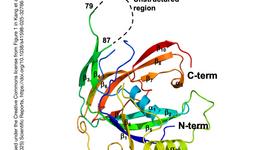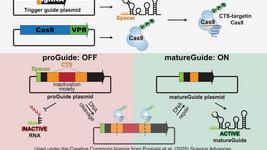Carbon
CARBON Newsletter (27 May 2025) - Your Latest News About CRISPR in AgroBio
By: Gorm Palmgren - May. 27, 2025
CRISPR AgroBio News (CARBON) - an emerging initiative from CRISPR Medicine News - has been hibernating for two years, but now we are back on track again.
CARBON will bring you the latest news on how CRISPR can shape agriculture for the future to guarantee food security in times of population growth and climate change.
To get more CRISPR AgroBio News delivered to your inbox, sign up to the free weekly CARBON Newsletter here.
Top picks
- Scientists developed a comprehensive molecular toolkit for the northern star coral Astrangia poculata, including CRISPR-mediated gene knock-in for endogenous gene tagging alongside RNA-based knockdown and overexpression methods. These advances, combined with laboratory-induced spawning, establish A. poculata as the first tractable hard coral system for functional developmental studies, expanding beyond traditional cnidarian models like Hydra and Nematostella.
- An Israelian research team has developed genome-wide multi-targeted CRISPR libraries in tomatoes comprising 15,804 unique sgRNAs designed to simultaneously target multiple genes within the same families, generating approximately 1300 independent lines with distinct phenotypes affecting fruit development, flavour, and disease resistance. The approach includes CRISPR-GuideMap, a double-barcode tracking system, demonstrating scalable gene editing that overcomes functional redundancy challenges in crop breeding programmes. This multi-targeted strategy offers enhanced efficiency compared to traditional single-gene editing approaches for large-scale crop improvement.
Technical advances
- Researchers have systematically compared seven different methods for detecting and quantifying CRISPR edits in plants, testing 20 transiently expressed Cas9 targets to evaluate accuracy, sensitivity and cost against targeted amplicon sequencing as the benchmark. The study addresses the lack of standardised approaches across plant genome editing research, providing guidelines to help researchers select appropriate quantification techniques for different applications and improve comparability between studies.
- The first successful Agrobacterium tumefaciens-mediated genetic transformation of Melia volkensii has been achieved using a binary vector carrying the M24::eGFP reporter gene. The method establishes a foundation for future CRISPR-Cas9 applications to develop improved varieties of this drought-resistant African timber tree for reforestation programmes.
- Researchers optimised Agrobacterium-mediated transformation protocols for Platycodon grandiflorum and combined this with CRISPR-Cas9 to achieve 16.70% genome editing efficiency targeting the endogenous chr2.2745 gene. The improved A. rhizogenes system using morphogenic regulators Wus2 and ZmBBM2 enhanced plant regeneration to 21.88%, establishing an efficient platform for functional genomics research in this ornamental and medicinal plant.
- Korean scientists have developed a fluorescence-based assay in Arabidopsis thaliana protoplasts to demonstrate that RfxCas13d exhibits collateral RNase activity in plant systems. This activity degrades non-target RNAs alongside intended targets, particularly affecting recombinant plasmid-derived mRNAs. This collateral activity may limit Cas13's utility for precise plant genome editing applications.
- Researchers at the University of Wisconsin-Madison successfully produced transgene-free, gene-edited carrot plants by delivering CRISPR-Cas9 ribonucleoprotein complexes directly into protoplasts and regenerating whole plants. The team targeted the acid-soluble invertase isozyme II gene to potentially increase sucrose accumulation in carrot roots, achieving editing rates of 17.3% and 6.5% with two different guide RNAs, respectively.
- A Chinese team has developed miniaturised CRISPR-Cas12i genome editing tools for plants, demonstrating that Cas12i2Max achieved up to 68.6% editing efficiency in stable rice lines whilst maintaining high specificity. The smaller Cas12i proteins (∼1,000 amino acids versus ∼1,400 for Cas9) also enabled effective transcriptional activation and repression systems, expanding the CRISPR toolbox for simultaneous genome editing and gene regulation in monocot crops.
- Scientists established the first stable Agrobacterium-mediated transformation system for Elymus nutans, an important alpine forage grass, and successfully applied CRISPR-Cas9 to edit EnTCP4 with 19.23% efficiency. Knockout of EnTCP4 delayed flowering and enhanced drought tolerance, representing a breakthrough that enables functional genomics studies and molecular breeding in this economically important hexaploid grass species.
Disease and stress control
- Using CRISPR-Cas9, researchers disrupted ZmGAE1, a negative regulator of maise resistance to Fusarium ear rot. They discovered that a natural 141-bp indel insertion in the gene's promoter reduces expression and enhances disease resistance. Functional validation showed that decreased ZmGAE1 expression not only improves resistance to multiple diseases but also reduces fumonisin content without affecting key agronomic traits, making it a promising target for crop improvement.
- CRISPR-Cas9 mutagenesis of SiEPF2 in foxtail millet (Setaria italica) reduced both drought tolerance and yield by disrupting the gene's regulation of stomatal density and panicle morphology. The study demonstrates that SiEPF2 plays a crucial balancing role between abiotic stress responses and reproductive development, providing insights for optimising drought resistance whilst maintaining yield in millet breeding programmes.
- Scientists have employed CRISPR-Cas9 to knock out the OsPsbS1 gene in rice, which normally controls photoprotective mechanisms. They discovered that this disruption causes premature leaf senescence through excessive reactive oxygen species accumulation. The mutant plants exhibited pale-yellow leaves, reduced chlorophyll content, accelerated chloroplast degradation, and programmed cell death, revealing OsPsbS1's critical role in preventing premature ageing in rice leaves.
- Map-based cloning identified StNADC (encoding nicotinate-nucleotide pyrophosphorylase) as a central senescence regulator in tetraploid potatoes. CRISPR-Cas9 knockout mutants exhibited extremely early senescence and 87% reduced NAD content. The study demonstrated that StNADC is essential for NAD synthesis and that supplementing downstream NAD pathway products can rescue the mutant phenotype, suggesting NAD metabolism as a promising target for controlling senescence in potato breeding programmes.
Agronomic traits
- Multiplex CRISPR genome editing targeting three SlGA3ox genes in tomatoes created compact plant architectures suitable for vertical farming, with slga3ox3 slga3ox4 double mutants showing the most promising space-efficient phenotype. The study demonstrated that manipulating gibberellin biosynthesis genes can effectively tailor plant architecture for controlled environment cultivation whilst maintaining yield potential.
- CRISPR-Cas9 knockout of PagGLR2.8 in hybrid poplar (Populus alba × P. glandulosa) improved fibre quality by altering vascular tissue development, resulting in enhanced mechanical and fire-resistance properties when incorporated into polylactic acid composites. The engineered plant fibres significantly outperformed pure polylactic acid (PLA) in strength, modulus, fire resistance, and anti-dripping properties, demonstrating the potential for genetic modification to optimise plant-derived materials for sustainable composite applications.
- A CRISPR-Cas9 knockout mutant library in rice identified csd-1, a semi-dwarf mutant with a T-nucleotide insertion in β-ketoacyl-CoA synthase 11 (KCS11), which catalyses the initial step in very-long-chain fatty acid elongation. The mutant exhibited reduced plant height, panicle length, and seed characteristics, with altered fatty acid profiles and increased cytokinin levels, revealing a novel link between very-long-chain fatty acid metabolism and cytokinin synthesis via acetyl-CoA.
- CRISPR-Cas9 knockdown of StSS5 in dihaploid potato revealed contrasting effects on starch granule formation between leaf chloroplasts and tuber amyloplasts. The ss5 mutants produced fewer starch granules in the leaves. Still, they showed supernumerary granule initiation, leading to compound granules in tubers, along with reduced tuber weight and starch accumulation, demonstrating StSS5's critical role in controlling granule initiation across different potato tissues.
- CRISPR-Cas9 modulation of the vacuolar H⁺-translocating pyrophosphatase (VPP5) promoter in rice improved spikelet fertility and reduced grain chalkiness under high nighttime temperature stress. RNA sequencing revealed that the vpp5mutants showed downregulated heat shock protein expression and altered prolamin accumulation, suggesting multiple metabolic pathways contribute to enhanced heat tolerance beyond starch biosynthesis modifications.
Industry
- Spearhead Bio is a new spinoff of The Danforth Technology Company, exploiting the TAHITI (Transposase Assisted Homology Independent Targeted Insertion) technology that complements CRISPR by enabling precise gene insertion at specific genomic locations. While CRISPR excels at cutting genes, TAHITI addresses the major limitation of controlled gene placement, using natural transposable elements to insert genetic material faster and more precisely than random insertion methods, potentially making CRISPR more viable for agricultural applications.
- Syngenta Vegetable Seeds has partnered with Tropic to deploy the company's Gene Editing induced Gene Silencing (GEiGS®) technology, which combines precision gene editing with RNAi to tackle disease resistance in commercial vegetable crops. The collaboration aims to strengthen Syngenta's vegetable portfolio by providing rapid responses to emerging disease threats that are becoming more prevalent due to climate change.
- Ecuador's Ministry of Agriculture has approved Cibus' herbicide tolerance rice traits (HT1 and HT3) as equivalent to conventional breeding, determining they don't require GMO regulations. The traits were developed using Cibus' Rapid Trait Development System™ (RTDS®), which enables targeted genetic changes without integrating foreign DNA. This paved the way for commercialisation through partnerships with Interoc and other seed companies across Latin America.
- Bayer will consolidate its Crop Science R&D and production in Germany by 2028, focusing on strategic technologies to remain competitive amid pressure from low-cost Asian generics. Production in Frankfurt will be sold or relocated; Monheim will become the central R&D hub. Dormagen will streamline operations, discontinuing generic actives to prioritise differentiated, innovation-driven products aligned with Bayer's five-year global competitiveness plan.
- Inari has opened a high-tech greenhouse facility in Ghent, tripling its indoor plant growth capacity in Europe. The site will accelerate the R&D of SEEDesign™ crops using AI-driven predictive design and multiplex gene editing. Customisable growth conditions and sustainability features support the rapid development of region-specific traits, aligning with evolving EU genomic regulations and reinforcing Inari's strategic focus on European agriculture.
Detection
- Researchers have developed a rapid RAA-CRISPR-Cas12a detection system targeting the recN gene that identifies Streptococcus suis in swine within 30 minutes at $1 per test, achieving superior sensitivity and 100% specificity compared to conventional PCR methods. This field-deployable approach enables cost-effective on-site pathogen detection in farms and fresh pork, supporting outbreak control in the livestock industry.
- A study characterising Magnaporthe oryzae isolates from southern India developed a novel CRISPR-Cas12a detection system targeting the conserved tyrosinase gene, coupled with recombinase polymerase amplification for rapid field diagnosis. The system demonstrated high sensitivity (detecting 10⁻¹/µL DNA copies) and successfully identified the rice blast pathogen in leaf, neck, and seed samples using fluorescence and lateral flow assays, offering a robust tool for early disease detection.
Perspectives
- A Spotlight in Trends in Biotechnology discusses recent work by Weiss et al. Here, the researcher demonstrated viral delivery of the compact genome editor TnpB into Arabidopsis thaliana, achieving transgene-free heritable modifications that could transform plant biotechnology by enabling field-deployable genome editing as simple as pesticide application.
- An editorial in Frontiers in Genome Editing highlights CRISPR as a transformative tool for crop improvement, discussing recent advances, including enhanced micronutrient accumulation in rice through OsNAS2 promoter editing and novel CRISPR variants like RNA editing, base editors, and prime editors. The authors emphasise CRISPR's potential to address agricultural challenges whilst acknowledging ongoing obstacles, including regulatory frameworks, intellectual property issues, and technical limitations in polyploid crops and polygenic trait manipulation.
- An editorial by The African Centre for Technology Studies (ACTS) examines CRISPR-Cas9's application in developing disease-resistant crops, highlighting successful implementations in wheat (TaMLO gene for powdery mildew resistance), rice, soybean, and sweet orange. The authors emphasise CRISPR's advantages over traditional breeding methods, including precision targeting of susceptibility genes, reduced reliance on chemical pesticides, and faster development timelines. The piece particularly focuses on Africa's potential to leverage CRISPR for climate-resilient crops, with ongoing projects including disease-resistant banana, maise resistant to lethal necrosis, and Striga-resistant sorghum to address regional food security challenges.
Reviews
- Speed breeding 3.0: mainstreaming light-driven plant breeding for sustainable genetic gains. This comprehensive review introduces "Speed breeding 3.0" – an advanced light-driven plant breeding approach that uses full-spectrum LED technology and optimised protocols to accelerate crop development cycles dramatically. The authors present this as a transformative solution to address global food security challenges by enabling up to six generations per year in crops like wheat, rice, and barley, compared to traditional methods that support only 1-2 cycles annually.
- Precise genome editing process and its applications in plants driven by AI. This review traces the evolution of genome editing from early meganucleases and TALENs to CRISPR-Cas systems and next-generation tools like base and prime editors while examining how AI integration is now transforming the field by optimising editing systems, predicting site efficiency, and designing strategies for enhanced plant breeding applications.
- The next Green Revolution: integrating crop architectype and physiotype. This review explores the potential for a new Green Revolution by defining optimal crop 'architectypes' and 'physiotypes' – representing idealised morphological and physiological traits respectively – suggesting that integrating these concepts through advanced genomic technologies could enhance yields and resource efficiency by 20–30%.
- A panorama of recent advances in genetic improvement of tobacco. This review systematically analysed 97 studies on Nicotiana tabacum genetic improvement from 2019-2023, finding that research predominantly focuses on developing stress tolerance, disease resistance, and enhanced metabolism through genetic engineering and gene editing approaches, with most work concentrated in Asian countries, particularly China.
- Harnessing neo-domestication of wild pigmented rice for enhanced nutrition and sustainable agriculture. This review examines neo-domestication approaches for wild pigmented rice using CRISPR-Cas editing toolboxes to rapidly develop high-yielding varieties that retain beneficial traits like disease resistance, stress tolerance, and nutritional antioxidants lost during traditional domestication.
- Unlocking genetic potential: a review of the role of CRISPR/Cas technologies in rapeseed improvement. This review examines the application of CRISPR-Cas technologies in rapeseed (Brassica napus) breeding, discussing the principles and mechanisms for targeted gene knockout, editing, and transcriptional regulation in this complex allotetraploid crop.
- Perspectives on the use of the CRISPR system in plants to improve recombinant therapeutic protein production. This review examines how CRISPR technology can enhance plant-based production of recombinant therapeutic proteins by optimising glycosylation patterns for humanisation, engineering metabolic pathways to increase protein accumulation, and enabling precise transgene integration for improved expression stability and yield.
Tags
CLINICAL TRIALS
IND Enabling
Phase I
Phase II
Phase III
Gastric Cancer and Colorectal Cancer, CRC, (NCT07166263)
Sponsors:
Base Therapeutics (Shanghai) Co., Ltd.
Sponsors:
Base Therapeutics (Shanghai) Co., Ltd.
IND Enabling
Phase I
Phase II
Phase III
Relapsed or Refractory Acute Myeloid Leukemia, AML, (NCT06541444)
Sponsors:
Base Therapeutics (Shanghai) Co., Ltd.
Sponsors:
Base Therapeutics (Shanghai) Co., Ltd.
IND Enabling
Phase I
Phase II
Phase III







